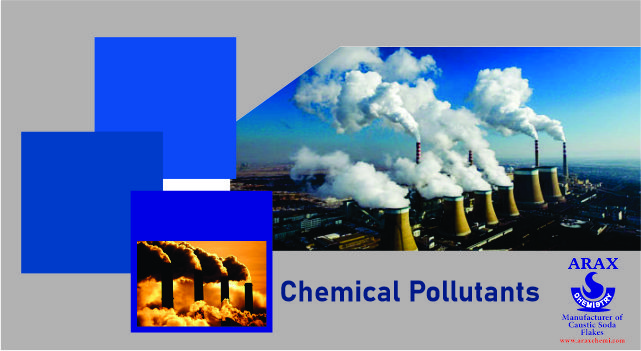Chemical pollutants
Chemical pollutants are divided into organic and mineral groups.
Organic compounds contain carbon and hydrogen. Some organic particles are found in the atmosphere more than other organic particles,
These include phenols, organic acids, and alcohol.
The most famous minerals in the atmosphere are nitrates, sulfates, and metals such as iron, lead, zinc, and vanadium.
Sources of pollutants
The air has natural pollutants such as fungal spores, plant seeds, particles of salt and smoke, and particles of dust from forest floods and eruptions of volcanoes.
Also, the air contains carbon monoxide gas produced naturally (CO) from the decomposition of methane (CH4) and hydrocarbons in the form of tropanes from pine trees, hydrogen sulfide (H2S), and methane (CH4) from the anaerobic degradation of organic matter.
The sources of pollutants, in general, can be classified into four main categories:
Chemical pollutants
Includes motor vehicles, air vehicles, trains, ships, and any kind of use or evaporation of gasoline,
Including the supply of energy and heat for residential, commercial, and industrial purposes, power generating plants that operate with steam,
Such as the chemical industry, metallurgy, paper production, and oil refineries,
Includes residues from domestic and commercial use, coal waste, and ash remaining from the burning of agricultural remains.
Hydrocarbons
Organic compounds that only contain hydrogen and carbon are called hydrocarbons, which are generally divided into two groups.
• Aliphatic hydrocarbons
The aliphatic hydrocarbon group includes alkanes, alkenes, and alkanes.
The alkanes are saturated hydrocarbons that are not involved in atmospheric photochemical reactions.
The alkenes commonly referred to as olefins,
Are not saturated and somewhat active in photochemical in the atmosphere.
This group reacts at high concentrations in the presence of sunlight with nitrogen oxides
And secondary pollutants such as proxy acetyl nitrate (PAN) and ozone (O3).
The aliphatic hydrocarbons produced up to about 326 mg / m3 for human and animal health are not risky.
aromatic hydrocarbons
Aromatic hydrocarbons are biochemically and biologically active, some of them potentially carcinogenic,
Either derived from benzene or related to it.
An increase in the incidence of lung cancer in urban areas has been attributed to multi-nuclear hydrocarbons exhausted from cars.
Benzo pyrin is the worst cancer of hydrocarbons.
Sources of hydrocarbons
Driveshaft and carburetors have the highest percentage of hydrocarbon release.
Complementary combustion equipment that works with the catalyst releases hydrocarbons and burns carbon monoxide and generates CO2 and water.
Hydrocarbon control technology derived from residential resources
Hydrocarbon control technology derived from residential sources include gravel, adsorption, condensation, and alternative materials.
The graveling process is carried out with supplementary combustion devices and catalytic burners.
Carbon monoxide
The carbon monoxide gas is odorless and colorless, tasteless and under normal conditions, it is chemically ineffective and has an average lifespan of about 2.5 months in the atmosphere.
At present, the amount of carbon monoxide in the atmosphere is ineffective or less effective on human assets, plants, and objects.
In high concentrations of carbon monoxide, due to its high tendency to absorb hemoglobin, it can seriously disrupt human respiratory metabolism.
The concentration of carbon monoxide in densely populated urban areas where heavy traffic and vehicle movement are slow,
Significantly increases.
Carbon sources are natural and human carbon monoxide.
Carbon monoxide control standards
When the amount of carbon monoxide in a short time reaches deadly levels and becomes an emergency,
To cope with such conditions, when the amount of CO reaches an average of 46 mg / m3 (40ppm) over a period of 8 hours,
Extreme control operations are performed which include:
Stopping industrial factories and blocking roads where there is usually heavy traffic.
Absorption, adsorption, condensation, and combustion are the technical methods for controlling CO.
Sulfur oxides
Chemical pollutants
These oxides include six different gas combinations:
Sulfur monoxide (SO), sulfur dioxide (SO2), sulfur trioxide (SO) sulfur tetraoxide (SO4), sulfur dioxide
Sulfur oxide (SO2) and sulfur heptoxides (S2O7). In the study of air pollution,
Sulfur dioxide and sulfur trioxide are most important.
Due to the relative stability of SO2 in the atmosphere, this can act as an oxidizing or reducing agent.
SO2, which reacts with other components present in the atmosphere in the form of a photochemical or catalytic process,
It can produce sulfuric acid droplets (H2SO4) and sulfuric acid salts.
SO2 reacts with water, producing sulfuric acid.
This weak acid is associated with more than 80% SO2 released into the atmosphere from human activities to burn solid and fossil fuels.
Sulfur oxide control standards
Extensive methods for controlling sulfur oxide include:
The use of fewer sulfur fuels, the separation of sulfur from fuel, the replacement of other energy sources,
Conversion of coal into liquid or gas, cleaning of combustion products.
Nitrogen oxides
It contains nitrogen monoxide (NO), nitrogen dioxide (NO2), nitrous oxide (N2O).
nitrogen cis-oxide (N2O3), are Nitrogen tetroxide (N2O4) and Nitrogen Pentoxide (N2O5).
Two important gases in the air pollution equations are:
Nitric acid (NO) and nitrogen dioxide, nitrogen dioxide, which is heavier than air and soluble in water.
In water, it forms nitric acid or nitric acid, or nitric oxide (NO).
Nitric acid and nitro acid have fallen to the surface as a result of rainfall,
Or with ammonia in the atmosphere (NH3), which combines ammonium nitrate (NH4NO3).
In this case, NO2 is a component of plant nutrition.
NO2, which is good absorbent energy in the ultraviolet radiation range,
In the production of secondary pollutants such as ozone, O3 plays an important role. The amount of NO released in the atmosphere is far more than NO2 released.
NO is produced in high-temperature combustion processes due to the combination of nitrogen and oxygen.
Nitrogen oxide sources
Some nitrogen oxides are naturally occurring and some form humans.
A small amount of NO2 comes from forest fires. Bacterial decomposition of organic matter also liberates NO2 in the atmosphere.
In fact, NO2-producing resources are approximately ten times as tight as human resources in urban areas of concentration and concentration.
The major part of NO2 generated from human resources is the combustion of fuel in residential and transport vehicles.
Nitrogen oxide control standards
Often control measurements for NO2 are released in order to limit combustion conditions and reduce NO2 production as well as the use of diverse equipment to remove NO2 from exhaust gases.
Photochemical oxidants
Chemical pollutants
Oxidizers or full oxidizers are two phrases used to describe photochemical oxidizing agents and
Usually, they indicate the ability to oxidize the air in the atmosphere.
Ozone (O3), a major photochemical oxidizer, accounts for about 90% of oxidizing agents.
Other important photochemical oxidants in air pollution control are:
Neonatal oxygen (O), Excited molecular oxygen (O2), Proxy acyl nitrate (PAN), Proxy propanol nitrate (PPN)
Proxy butyl nitrate (PBN), nitrous oxide (NO2), hydrogen peroxide (H2O2), and alkyl nitrate.
The effects of oxidizing agents
The effects of oxidants on human health can cause coughing, shortness of breath, airway obstruction, chest pain,
Inappropriate lung function, red blood cell changes, dry swelling, and burning eyes, nose, and throat.
ARAX CHEMISTRY is a great manufacturer of Caustic Soda Flakes, Aluminum Sulfate, and Copper Sulfate which offers its High-quality products

